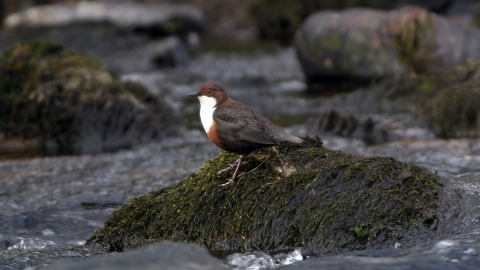
Dipper - Brian Phipps
Bishopswood Meadows
Location
Know before you go
Dogs
Visit the 'Dog walking on reserves' page in the Contact section for more information.
When to visit
Opening times
Open at all timesBest time to visit
April to JulyAbout the reserve
The reserve comprises five fields on a gentle north-facing slope with the River Yarty at the base. Much of the wildlife interest at the reserve is due to its history relating to the lime burning industry. The mix of calcareous (lime rich) and neutral soil conditions have provided habitat for a good range of plant life. Old spoil heaps created by quarrying activity are much liked by Cowslips, Dwarf Thistle and Quaking Grass. Early Purple Orchids and Common Spotted Orchids also occur across the reserve. Common Blue, Ringlet and Marbled White butterflies can all be seen in summer.
The wetter fields have areas of rush pasture with species such as Marsh Marigolds and Ragged Robin.
The River Yarty, which borders part of the reserve, is an important habitat in its own right and is used by Otters, Kingfishers and Dippers. The large Golden Ringed Dragonfly is also a regular here.
All of the fields in the reserve have thick hedgerows of Hazel, Field Maple, Ash and Holly which is great habitat for the Hazel Dormice that occur in the reserve.
Reserve conservation management - The management of the reserve aims to maintain and improve the existing habitats by a mixture of hay cutting and grazing. Small sections of scrub are cleared from the areas where the ground is steep and so grazed less heavily. This management should maintain the existing wildlife rich areas and, in time increase the species diversity in the previously agriculturally improved parts of the reserve.
The hedges are trimmed on a rotation in the late winter thereby ensuring a supply of nuts and berries for birds and mammals in the uncut sections. Sections are traditionally layed at intervals.
History and Archaeology - The underlying geology is mostly lower Lias Group clays and limestones. In the second half of the 19th century an extensive lime burning industry was based around the Bishopswood area. Lime was used in the production of lime mortar and was also spread on fields to boost crop growth. The reserve has the remains of a limekiln, this has been partially restored and is fenced off.
The impact of this industrial activity is still obvious today with distinctive key hole shaped quarry spoil heaps, tailings, access tracks and paths still clearly discernible within the reserve.
Close to Mount Fancy Farm Butterfly Conservation Reserve.

